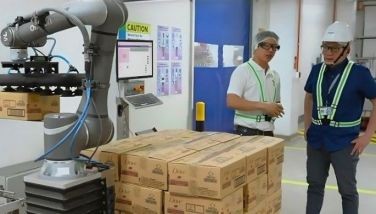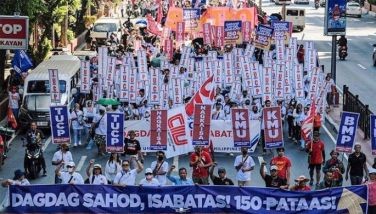Courtside With The Doha Duo
November 26, 2006 | 12:00am
The 15th Asian Games in Doha, Qatar next month will see the participation of a lean and, hopefully, mean Philippine team. On this team are two Filipinas who will raise their tennis rackets for country and glory.
Czarina Mae Arevalo is 21 and Denise Dy is 17. Both are right-handed players who specialize in the double-backhand. They graciously granted STARweek an interview between games during the recent two-week Holcim ITF international tournament at the Ninoy Aquino Sports Complex tennis courts. Both legs of the tournament were won by Fil-Am players: Stacey Tan triumphed in the first leg and Maureen Diaz beat out all opponents in the second.
While Arevalo is homegrown all the way, Dy was born and raised in the United States. Both, though, are proud and excited to carry the flag on their tennis shirts, even if they may seem very restrained, shy even, during the interview.
"I am proud to be part of Team Philippines," Arevalo says with a Maria Clara smile. "I can only do my best in Doha and hope that it is good enough for a victory."
Dy is more forthright: "I’m going to give it my best shot, though there are a lot of other players out there who are very good."
Both Arevalo and Dy found themselves on the tennis court early–Arevalo was nine years old when she started hitting a tennis ball and Dy was eight when she was introduced to the sport by her uncle. Dy’s coach is Alexander Kozyrev.
"Since then I’ve been playing because I love it," Dy says. Her preferred arena is the grass court. Arevalo picked up on tennis from her dad who was a player on the club circuit. She prefers to play on a hard court.
Their tans, deep and becoming, are the first sign that they are dedicated tennis players. Their wiry musculature and posture are the next thing one sees that indicate that, yes, they are seriously into tennis, indeed. And on court there’s nothing shy or restrained about this pair.
At 17, Dy has had bouts of tennis elbow, among other sports injuries. Arevalo simply nods when asked if she has had any injuries and says "sprains, they hurt a lot."
Life on the tennis tournament circuit is fluid and one that requires a lot of travel. Dy confesses that she "hates flying" but loves the travel because "I meet a lot of people and I’ve made friends with a lot of people."
Her traveling does not interfere with her studies, since she is home-schooled, though "after a hard day on the court, all you wanna do sometimes is get in bed in your hotel and just sleep–not do homework."
Arevalo, too, has had to choose between her studies and her sport. A student of interdisciplinary studies at the Ateneo de Manila, she intends to go back to school "and finish my course" after her stint in Doha.
Off court, Dy likes to listen to music, read and do other sports like snowboarding. "My mother said she would rather have me play tennis and sprain an ankle than have me get into a sport that would break my neck," she says with mischievous glee.
The problem with being a tennis player in the Philippines, Dy adds, "is that there aren’t too many people who are interested in the sport. You don’t see packed stands here during tournaments. Perhaps if more people came out to watch us, the people who sponsor us will be more willing to support us financially."
"Yes, if more people see the sponsors’ banners and names during the tennis matches here, maybe our sponsors will be encouraged to provide more support for Philippine tennis players," Arevalo concurs. "That would be really good for the sport."
As it is, tennis is not exactly an affordable sport, with today’s evolution of tennis shoes costing between P3,000 and P6,000 a pair and tennis rackets costing even more than that. Then there are the balls, those fuzzy things that wear out and grow bald every few sets. We haven’t even gone into tennis court fashion as made famous by Maria Sharapova.
Arevalo and Dy are among the more fortunate athletes of Team Philippines. They have a supportive sponsor in cement manufacturer Holcim Philippines, which pays for their plane tickets and board and lodging. Holcim chair Oscar Hilado is an avid tennis buff, and personally supports budding players.
Such sponsorship is costly, according to people in the know, as serious training in tennis–including training under good coaches and equipment–may come to about $1 million a year.
Add to this the advice given by tennis coaches to the parents of aspiring tennis players that they begin serious training for their children at as young an age as possible, preferably from the age of six.
So, is tennis a sport for Filipinos? "Well, I think that the Filipino athlete and the Filipino in general can achieve what he or she wants to achieve," Dy says. "It is not a matter of whether someone else says you can do it–it is a matter of whether you decide to do it."
"I think that the Filipino can excel in tennis, if they want to," Arevalo adds. "It is up to us to excel in the sport we choose."
And can they bring home Doha gold? The initial answer to this question was nervous laughter and an awkward pause before Dy pipes in: "Well, we’ll do our best and that is all we can promise, really."
A nod and another pause later, Arevalo exhales and laughs before saying: "That question is not easy to answer, but I will get out there and do my best. Yun lang (that’s all)."
Much as the Arevalo and Dy love their sport–it does show, after all, in the sparkle in their eyes as they discuss the players they have watched or played on the circuit– they are both pragmatic about preparing career alternatives should tennis not be their final destiny.
"I would like to learn management or how to run a business," Arevalo says. "I may continue my studies in Ateneo or shift courses."
"I’d like to finish college," Dy says, though she admits that she has not decided what to major in or even where to study. "All I know is that I hope that being a tennis player will help me get into college on a scholarship."
For Doha, these girls may dream of gold, as does all the athletes of Team Philippines, but they dream of moral support from their countrymen as well.
"It would be so nice to see Filipinos cheering us on, waving the flag from the stands," Dy says. "That would be so cool."
"I’d love to see even half the number of basketball fans at courtside," Arevalo adds, nodding and smiling. "That would be inspiring."
And the spirit that these two girls show is pretty inspiring too.
Czarina Mae Arevalo is 21 and Denise Dy is 17. Both are right-handed players who specialize in the double-backhand. They graciously granted STARweek an interview between games during the recent two-week Holcim ITF international tournament at the Ninoy Aquino Sports Complex tennis courts. Both legs of the tournament were won by Fil-Am players: Stacey Tan triumphed in the first leg and Maureen Diaz beat out all opponents in the second.
While Arevalo is homegrown all the way, Dy was born and raised in the United States. Both, though, are proud and excited to carry the flag on their tennis shirts, even if they may seem very restrained, shy even, during the interview.
"I am proud to be part of Team Philippines," Arevalo says with a Maria Clara smile. "I can only do my best in Doha and hope that it is good enough for a victory."
Dy is more forthright: "I’m going to give it my best shot, though there are a lot of other players out there who are very good."
Both Arevalo and Dy found themselves on the tennis court early–Arevalo was nine years old when she started hitting a tennis ball and Dy was eight when she was introduced to the sport by her uncle. Dy’s coach is Alexander Kozyrev.
"Since then I’ve been playing because I love it," Dy says. Her preferred arena is the grass court. Arevalo picked up on tennis from her dad who was a player on the club circuit. She prefers to play on a hard court.
Their tans, deep and becoming, are the first sign that they are dedicated tennis players. Their wiry musculature and posture are the next thing one sees that indicate that, yes, they are seriously into tennis, indeed. And on court there’s nothing shy or restrained about this pair.
At 17, Dy has had bouts of tennis elbow, among other sports injuries. Arevalo simply nods when asked if she has had any injuries and says "sprains, they hurt a lot."
Life on the tennis tournament circuit is fluid and one that requires a lot of travel. Dy confesses that she "hates flying" but loves the travel because "I meet a lot of people and I’ve made friends with a lot of people."
Her traveling does not interfere with her studies, since she is home-schooled, though "after a hard day on the court, all you wanna do sometimes is get in bed in your hotel and just sleep–not do homework."
Arevalo, too, has had to choose between her studies and her sport. A student of interdisciplinary studies at the Ateneo de Manila, she intends to go back to school "and finish my course" after her stint in Doha.
Off court, Dy likes to listen to music, read and do other sports like snowboarding. "My mother said she would rather have me play tennis and sprain an ankle than have me get into a sport that would break my neck," she says with mischievous glee.
The problem with being a tennis player in the Philippines, Dy adds, "is that there aren’t too many people who are interested in the sport. You don’t see packed stands here during tournaments. Perhaps if more people came out to watch us, the people who sponsor us will be more willing to support us financially."
"Yes, if more people see the sponsors’ banners and names during the tennis matches here, maybe our sponsors will be encouraged to provide more support for Philippine tennis players," Arevalo concurs. "That would be really good for the sport."
As it is, tennis is not exactly an affordable sport, with today’s evolution of tennis shoes costing between P3,000 and P6,000 a pair and tennis rackets costing even more than that. Then there are the balls, those fuzzy things that wear out and grow bald every few sets. We haven’t even gone into tennis court fashion as made famous by Maria Sharapova.
Arevalo and Dy are among the more fortunate athletes of Team Philippines. They have a supportive sponsor in cement manufacturer Holcim Philippines, which pays for their plane tickets and board and lodging. Holcim chair Oscar Hilado is an avid tennis buff, and personally supports budding players.
Such sponsorship is costly, according to people in the know, as serious training in tennis–including training under good coaches and equipment–may come to about $1 million a year.
Add to this the advice given by tennis coaches to the parents of aspiring tennis players that they begin serious training for their children at as young an age as possible, preferably from the age of six.
So, is tennis a sport for Filipinos? "Well, I think that the Filipino athlete and the Filipino in general can achieve what he or she wants to achieve," Dy says. "It is not a matter of whether someone else says you can do it–it is a matter of whether you decide to do it."
"I think that the Filipino can excel in tennis, if they want to," Arevalo adds. "It is up to us to excel in the sport we choose."
And can they bring home Doha gold? The initial answer to this question was nervous laughter and an awkward pause before Dy pipes in: "Well, we’ll do our best and that is all we can promise, really."
A nod and another pause later, Arevalo exhales and laughs before saying: "That question is not easy to answer, but I will get out there and do my best. Yun lang (that’s all)."
Much as the Arevalo and Dy love their sport–it does show, after all, in the sparkle in their eyes as they discuss the players they have watched or played on the circuit– they are both pragmatic about preparing career alternatives should tennis not be their final destiny.
"I would like to learn management or how to run a business," Arevalo says. "I may continue my studies in Ateneo or shift courses."
"I’d like to finish college," Dy says, though she admits that she has not decided what to major in or even where to study. "All I know is that I hope that being a tennis player will help me get into college on a scholarship."
For Doha, these girls may dream of gold, as does all the athletes of Team Philippines, but they dream of moral support from their countrymen as well.
"It would be so nice to see Filipinos cheering us on, waving the flag from the stands," Dy says. "That would be so cool."
"I’d love to see even half the number of basketball fans at courtside," Arevalo adds, nodding and smiling. "That would be inspiring."
And the spirit that these two girls show is pretty inspiring too.
BrandSpace Articles
<
>
- Latest
- Trending
Trending
Latest
Trending
Latest
Recommended



















